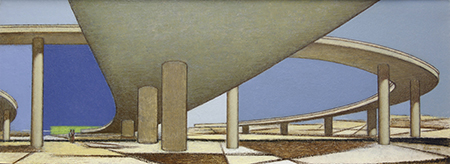
The artworks in “50/50: California Art in Transition (1940-1970)” recall the original iteration of “Pacific Standard Time: Art in L.A. 1945-1980” back in 2012. This show, presented as it is in a museum emphasizing California Scene Painting, is decidedly less edgy than most of those shows, concentrating on traditional representation, along with a regional response to the modernist developments of those decades. Jessie Arms Botke’s watercolor “Aviary, San Diego Zoo” (c. 1940), one of the show’s earliest paintings, is a detailed depiction of tropical birds, nesting and playing among intricate foliage. It fits in with the artist’s Japanese-inspired oil paintings of exotic birds and flowers. The contrasting oil “Mt. San Jacinto” (1949) by Paul Grimm illustrates the majestic landscape, mountains and sky of the Coachella Valley near Palm Springs, while echoing the plein air paintings of the early 20th century. Stylistically, Keith Crown’s “Sunset and Waves, Manhattan Beach” (1954) is decidedly more modern. Illustrating the southern California landscape, its colorful biomorphic shapes capture the artist’s responses to the sounds, wind and heat of the sun surrounding him. Roger Kuntz’s “Blimp Mooring” (1969) is one of several paintings featuring the Goodyear Blimp, and is representative of the artist’s reductive, modern style and use of light and shadow. Edward Biberman’s “Under the Freeway” (c. 1950) is even more reductive, with its spare and soaring shapes illustrating the underside of an early L.A. freeway. One of the more crowd pleasing paintings in this show is Millard Sheets’ watercolor of “Olvera Street” (1951). By contrasting downtown L.A.’s old-fashioned Mexican style market with the city’s towering art deco style City Hall, it simultaneously presents the old and the then new downtown Los Angeles.
